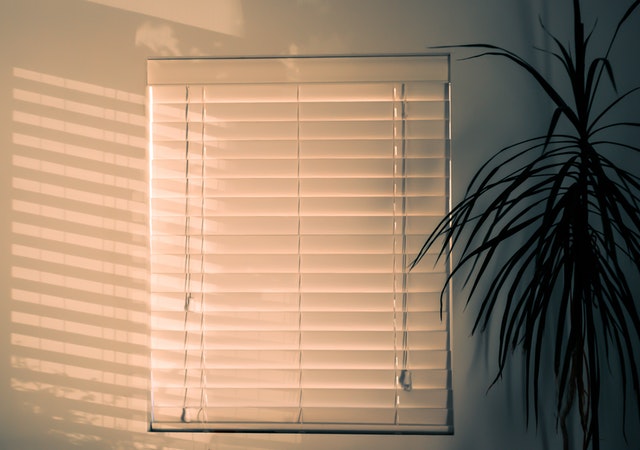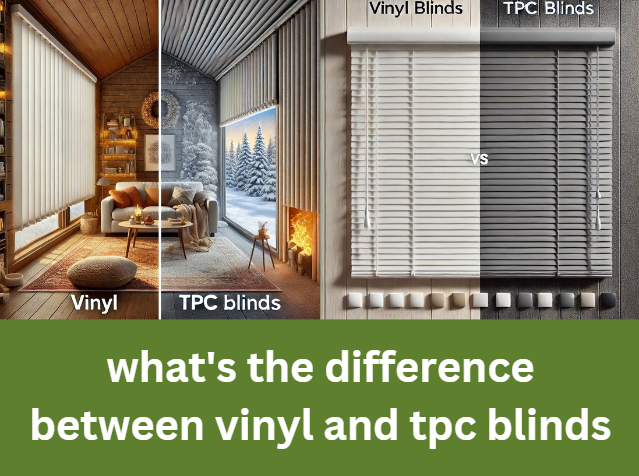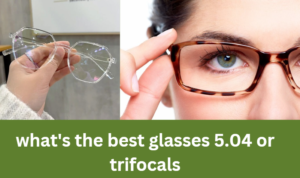Contents
- 1 Introduction
- 2 What Are Vinyl Blinds?
- 3 What Are TPC Blinds?
- 4 What’s the Difference Between Vinyl and TPC Blinds?
- 5 Pros and Cons of Vinyl Blinds
- 6 Pros and Cons of TPC Blinds
- 7 Which is Better: Vinyl or TPC Blinds?
- 8 Practical Applications: Where to Use Vinyl and TPC Blinds
- 9 FAQs About Vinyl and TPC Blinds
Introduction
When it comes to selecting the perfect blinds for your home or office, the options are overwhelming. One question that frequently arises is: “what’s the difference between vinyl and TPC blinds?” Whether you’re aiming to enhance the aesthetic appeal of your living space or find window treatments that offer practical functionality, choosing the right material is crucial. Blinds do more than block light; they offer privacy, energy efficiency, and contribute to your overall interior design.
In this article, we will explore the distinct features, advantages, and drawbacks of both vinyl and TPC blinds. Our goal is to help you make an informed decision that suits your needs, budget, and lifestyle. We will provide insights, analysis, and practical advice, going beyond the basic summaries found on most online sources.
What Are Vinyl Blinds?

Vinyl blinds are one of the most popular and affordable window treatment options available. Made from polyvinyl chloride (PVC), these blinds are lightweight, flexible, and resistant to moisture, making them ideal for rooms with high humidity such as kitchens, bathrooms, and laundry areas.
Key Features of Vinyl Blinds
- Affordability: Vinyl blinds are among the most cost-effective window covering options. Their low price point makes them accessible for many homeowners and renters who are looking for an inexpensive way to cover their windows.
- Durability in Humid Conditions: Since they are moisture-resistant, vinyl blinds are perfect for bathrooms and kitchens. They are less likely to warp, crack, or fade when exposed to high humidity.
- Easy Maintenance: Vinyl blinds are relatively easy to clean and maintain. A simple wipe-down with a damp cloth is often enough to remove dust and grime. This low-maintenance feature makes them appealing for busy households.
- Variety of Styles and Colors: Vinyl blinds come in a wide array of colors, sizes, and styles. Whether you’re looking for traditional slat blinds or modern vertical options, vinyl blinds can match various interior designs.
- Light Control: These blinds allow good control over light and privacy. The slats can be adjusted to let in the desired amount of sunlight or block it out entirely.
What Are TPC Blinds?

TPC blinds, also known as Thermoplastic Composite (TPC) blinds, are a more advanced and durable option for window treatments. TPC is a composite material made from thermoplastic resin combined with other materials to enhance its durability and flexibility. Unlike vinyl, TPC blinds are engineered to withstand more extreme conditions, making them suitable for high-traffic or commercial environments, as well as homes with demanding conditions.
Key Features of TPC Blinds
- Superior Durability: TPC blinds are built to last longer than vinyl blinds, thanks to their composite structure. They are resistant to extreme temperatures, UV rays, and general wear and tear. This makes them a great option for people looking for a long-lasting solution.
- Resistant to Warping and Fading: While vinyl blinds can become brittle and discolored over time when exposed to direct sunlight, TPC blinds maintain their shape and color for many years. This resistance to warping and fading makes TPC blinds a worthwhile investment.
- Flexibility: TPC materials are highly flexible, allowing the blinds to be more resistant to physical stress. This flexibility reduces the likelihood of the blinds cracking or breaking, even in challenging environments.
- Eco-Friendly Options: Many TPC blinds are made from environmentally friendly materials. If sustainability is important to you, TPC blinds offer an eco-conscious alternative, as many are recyclable and created with low-impact manufacturing processes.
- Better Insulation: One of the key advantages of TPC blinds is their superior insulation. These blinds are effective at maintaining indoor temperatures, which can help reduce energy costs over time by keeping rooms cooler in the summer and warmer in the winter.
What’s the Difference Between Vinyl and TPC Blinds?

Now that we’ve examined the key features of vinyl and TPC blinds, let’s take a deeper dive into the specific differences between the two. Below is a comparison across several important factors:
1. Material Composition
- Vinyl Blinds: Vinyl blinds are made from PVC (polyvinyl chloride), a plastic material that is cost-effective and moisture-resistant. While durable in wet environments, vinyl can sometimes feel less premium and may not offer the same long-term resilience as other materials.
- TPC Blinds: TPC blinds, on the other hand, are made from a composite of thermoplastic resin and other additives, giving them superior durability. TPC materials are engineered to handle extreme conditions better than PVC, ensuring a longer lifespan.
2. Durability
- Vinyl Blinds: Vinyl blinds are durable but may not withstand prolonged exposure to heat and direct sunlight as well as TPC blinds. Over time, vinyl can become brittle and more prone to cracking or warping in extreme conditions.
- TPC Blinds: TPC blinds are built to last, with better resistance to UV rays, temperature fluctuations, and general wear and tear. They are less likely to warp, crack, or fade compared to vinyl, making them a better choice for areas with harsh conditions.
3. Cost
- Vinyl Blinds: Vinyl blinds are one of the most affordable types of window treatments. If you’re on a tight budget or outfitting multiple windows, vinyl is an excellent choice for cost-conscious shoppers.
- TPC Blinds: TPC blinds generally come at a higher price point than vinyl blinds. However, their durability and long-term performance may make them a more cost-effective choice in the long run.
4. Aesthetic Appeal
- Vinyl Blinds: Vinyl blinds are available in a wide range of colors and styles, making them versatile for various decor themes. However, they tend to have a more basic look compared to higher-end materials, which may not suit every aesthetic preference.
- TPC Blinds: TPC blinds often have a more refined appearance. The composite materials allow for a sleeker, more modern finish. If you’re looking for a more premium look to complement your interior, TPC blinds may be a better option.
5. Maintenance
- Vinyl Blinds: Vinyl blinds are relatively easy to maintain, requiring only a quick wipe with a damp cloth to remove dust and dirt. However, over time, they may be more prone to discoloration, particularly in sunny rooms.
- TPC Blinds: TPC blinds are also easy to clean and offer better resistance to stains and discoloration. Their superior durability means they often require less frequent replacement, reducing the long-term maintenance cost.
6. Environmental Impact
- Vinyl Blinds: Vinyl is not the most environmentally friendly material, as it is derived from non-renewable sources and is not biodegradable. Recycling PVC can also be challenging.
- TPC Blinds: Many TPC blinds are manufactured with sustainability in mind. The materials used in TPC blinds are often more eco-friendly, and some manufacturers offer recyclable options. If you’re looking for a greener solution, TPC blinds may be the better choice.
Pros and Cons of Vinyl Blinds
Pros:
- Affordable: Ideal for homeowners on a budget.
- Moisture-resistant: Excellent for humid environments like kitchens and bathrooms.
- Low maintenance: Easy to clean and care for.
- Variety: Available in numerous styles, colors, and sizes.
Cons:
- Durability: Less resistant to wear and tear over time, particularly in extreme temperatures or direct sunlight.
- Aesthetic limitations: Can look basic compared to higher-end materials.
- Environmental impact: Made from non-renewable materials, which may not appeal to eco-conscious buyers.
Pros and Cons of TPC Blinds
Pros:
- Superior durability: Long-lasting and resistant to extreme conditions.
- Warp-resistant: Better suited for high-traffic or commercial environments.
- Eco-friendly options: Often made from recyclable and sustainable materials.
- Aesthetic appeal: Sleeker, more premium look compared to vinyl.
Cons:
- Higher cost: More expensive upfront compared to vinyl blinds.
- Availability: May be less widely available than vinyl blinds, especially in certain styles or colors.
Which is Better: Vinyl or TPC Blinds?
When considering “what’s the difference between vinyl and TPC blinds”, the answer depends on your specific needs:
- Choose Vinyl Blinds if you’re looking for a budget-friendly, moisture-resistant solution that requires minimal maintenance. Vinyl blinds are ideal for areas like bathrooms, kitchens, and laundry rooms where humidity is high, and the focus is on functionality over luxury.
- Choose TPC Blinds if you’re seeking long-term durability, better resistance to harsh environments, and a more eco-friendly option. TPC blinds may be more expensive upfront, but their longevity and ability to handle wear and tear make them a better investment in the long run.
Practical Applications: Where to Use Vinyl and TPC Blinds
Vinyl Blinds: Best Uses
- Bathrooms: Their moisture-resistant nature makes them perfect for humid environments.
- Kitchens: Easy to clean, making them ideal for areas that are prone to splashes and spills.
- Rental Properties: Affordable and easy to replace, vinyl blinds are a cost-effective choice for landlords.
TPC Blinds: Best Uses
- Living Rooms and Bedrooms: Their aesthetic appeal makes them great for areas where style matters.
- Office Spaces: TPC blinds’ durability makes them ideal for high-traffic areas.
- Sunrooms or Large Windows: Resistant to UV damage, they maintain their appearance even in direct sunlight.
FAQs About Vinyl and TPC Blinds
1. Which blinds are more durable, vinyl or TPC?
- TPC blinds are generally more durable than vinyl blinds, offering better resistance to extreme temperatures, UV rays, and general wear and tear.
2. Are vinyl blinds cheaper than TPC blinds?
- Yes, vinyl blinds are typically more affordable than TPC blinds. However, TPC blinds may offer better value over time due to their long-lasting durability.
3. Which blinds are better for high-humidity areas?
- Both vinyl and TPC blinds are resistant to moisture, but vinyl blinds are particularly suited for humid environments like bathrooms and kitchens.
4. Are TPC blinds environmentally friendly?
- Many TPC blinds are made from recyclable and sustainable materials, making them a more eco-friendly option than vinyl blinds, which are derived from non-renewable sources.
5. Do TPC blinds offer better insulation than vinyl blinds?
- Yes, TPC blinds typically provide better insulation, helping to regulate indoor temperatures and improve energy efficiency.
Conclusion
When deciding between vinyl and TPC blinds, the choice ultimately depends on your specific needs, budget, and preferences. Vinyl blinds offer a cost-effective, versatile solution that works well in many environments, particularly in high-humidity areas. On the other hand, TPC blinds provide superior durability, flexibility, and resistance to extreme conditions, making them a worthy investment for those seeking long-lasting window coverings.
By understanding the key differences between these two materials, you can make a more informed decision that enhances both the functionality and aesthetics of your space.





















+ There are no comments
Add yours